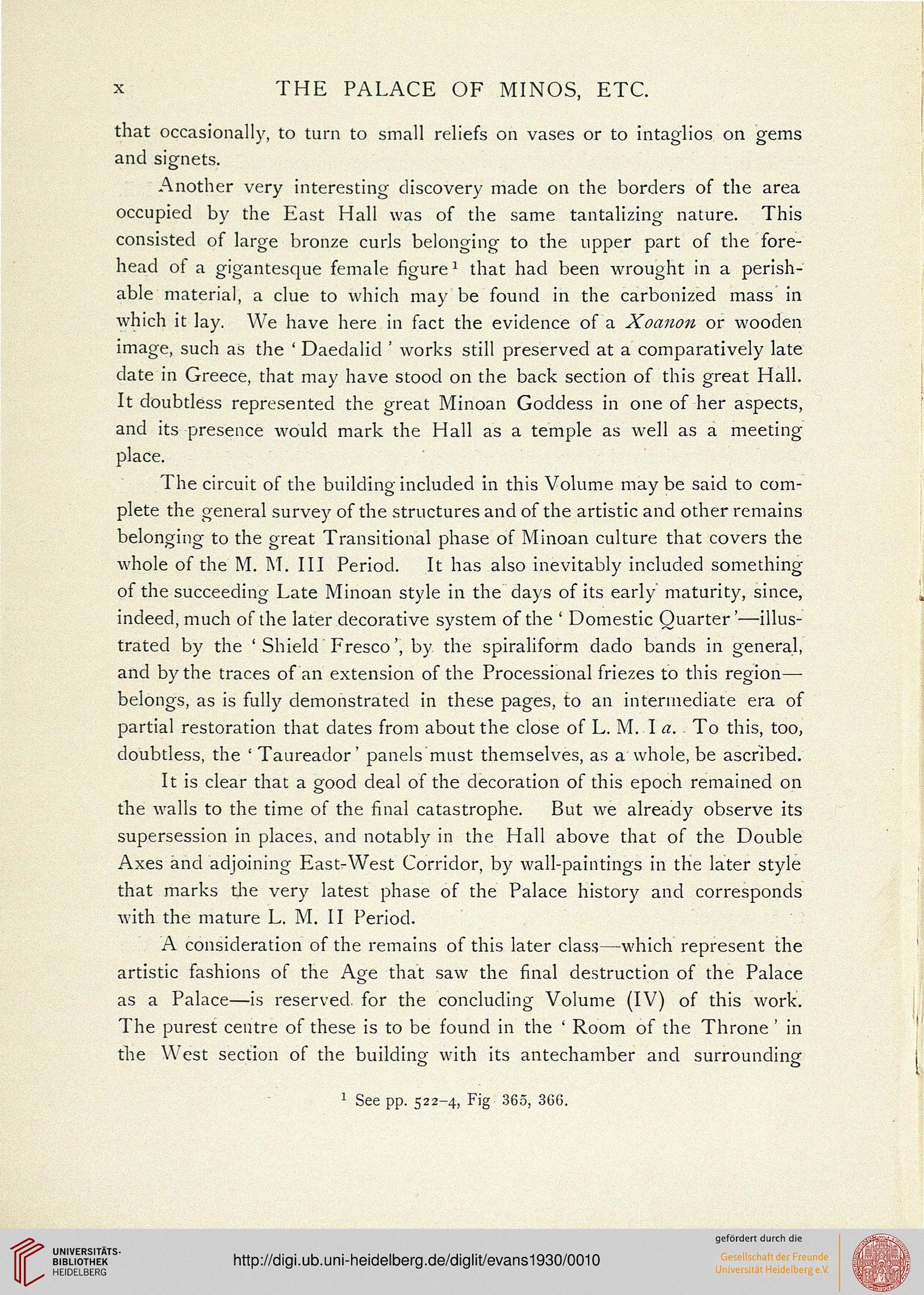x THE PALACE OF MINOS, ETC.
that occasionally, to turn to small reliefs on vases or to intaglios on gems
and signets.
Another very interesting discovery made on the borders of the area
occupied by the East Hall was of the same tantalizing nature. This
consisted of large bronze curls belonging to the upper part of the fore-
head of a gigantesque female figure1 that had been wrought in a perish-
able material, a clue to which may be found in the carbonized mass in
which it lay. We have here in fact the evidence of a Xoanon or wooden
image, such as the ' Daedalid ' works still preserved at a comparatively late
date in Greece, that may have stood on the back section of this great Hall.
It doubtless represented the great Minoan Goddess in one of her aspects,
and its presence would mark the Hall as a temple as well as a meeting
place.
The circuit of the building included in this Volume may be said to com-
plete the general survey of the structures and of the artistic and other remains
belonging to the great Transitional phase of Minoan culture that covers the
whole of the M. M. Ill Period. It has also inevitably included something
of the succeeding Late Minoan style in the days of its early" maturity, since,
indeed, much of the later decorative system of the ' Domestic Quarter'—illus-
trated by the ' Shield Fresco', by the spiraliform dado bands in general,
and by the traces of an extension of the Processional friezes to this region—
belongs, as is fully demonstrated in these pages, to an intermediate era of
partial restoration that dates from about the close of L. M. I a. To this, too,
doubtless, the ' Taureador' panels must themselves, as a whole, be ascribed.
It is clear that a good deal of the decoration of this epoch remained on
the walls to the time of the final catastrophe. But we already observe its
supersession in places, and notably in the Hall above that of the Double
Axes and adjoining East-West Corridor, by wall-paintings in the later style
that marks die very latest phase of the Palace history and corresponds
with the mature L. M. II Period.
A consideration of the remains of this later class—which represent the
artistic fashions of the Age that saw the final destruction of the Palace
as a Palace—is reserved, for the concluding Volume (IV) of this work.
The purest centre of these is to be found in the ' Room of the Throne ' in
the West section of the buildine with its antechamber and surrounding
1 See pp. 522-4, Fig 365, 366.
that occasionally, to turn to small reliefs on vases or to intaglios on gems
and signets.
Another very interesting discovery made on the borders of the area
occupied by the East Hall was of the same tantalizing nature. This
consisted of large bronze curls belonging to the upper part of the fore-
head of a gigantesque female figure1 that had been wrought in a perish-
able material, a clue to which may be found in the carbonized mass in
which it lay. We have here in fact the evidence of a Xoanon or wooden
image, such as the ' Daedalid ' works still preserved at a comparatively late
date in Greece, that may have stood on the back section of this great Hall.
It doubtless represented the great Minoan Goddess in one of her aspects,
and its presence would mark the Hall as a temple as well as a meeting
place.
The circuit of the building included in this Volume may be said to com-
plete the general survey of the structures and of the artistic and other remains
belonging to the great Transitional phase of Minoan culture that covers the
whole of the M. M. Ill Period. It has also inevitably included something
of the succeeding Late Minoan style in the days of its early" maturity, since,
indeed, much of the later decorative system of the ' Domestic Quarter'—illus-
trated by the ' Shield Fresco', by the spiraliform dado bands in general,
and by the traces of an extension of the Processional friezes to this region—
belongs, as is fully demonstrated in these pages, to an intermediate era of
partial restoration that dates from about the close of L. M. I a. To this, too,
doubtless, the ' Taureador' panels must themselves, as a whole, be ascribed.
It is clear that a good deal of the decoration of this epoch remained on
the walls to the time of the final catastrophe. But we already observe its
supersession in places, and notably in the Hall above that of the Double
Axes and adjoining East-West Corridor, by wall-paintings in the later style
that marks die very latest phase of the Palace history and corresponds
with the mature L. M. II Period.
A consideration of the remains of this later class—which represent the
artistic fashions of the Age that saw the final destruction of the Palace
as a Palace—is reserved, for the concluding Volume (IV) of this work.
The purest centre of these is to be found in the ' Room of the Throne ' in
the West section of the buildine with its antechamber and surrounding
1 See pp. 522-4, Fig 365, 366.




